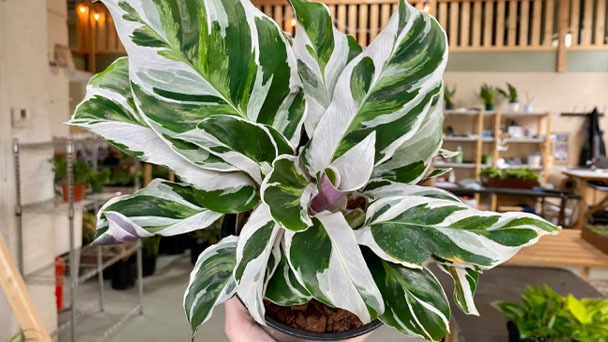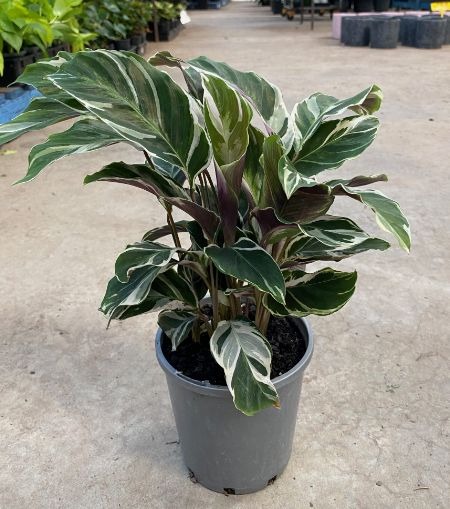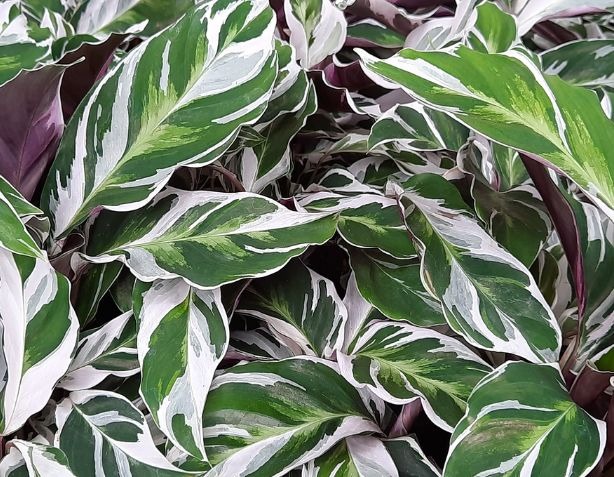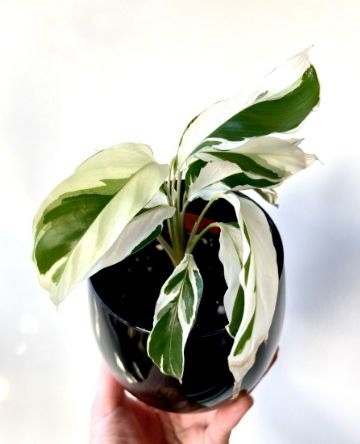How to Grow & Care for Calathea White Fusion
Written by Ivy
Jan 10 2023

It can be challenging to care for a Calathea White Fusion plant. The striking variegation of Calathea lietzei foliage has made it a very popular houseplant even though it can be difficult to grow.
Give your Calathea White Fusion a warm location away from the sun and maintain moisture to enjoy its lovely foliage for years.
What is the White Fusion Calathea
| Scientific Name | Calathea lietzei ‘Fusion White' |
| Common Name | Calathea White Fusion, Peacock Plant |
| Light | Bright indirect sunlight |
| Watering | Weekly, water if the top inch of soil is dry |
| Temperature | 60°F to 80°F (15 to 26ºC) |
| Hardiness Zone | 11b-12b |
| Humidity | 75-85% |
| Soil Type | quick-draining |
| Soil pH | 6.5 (mildly acidic) |
| Fertilizing | A balanced feed once a month in spring and summer |
| Repotting | Every 1-2 years |
| Pruning | As needed to remove dead leaves |
| Propagation | Root in water or soil or divide roots |
| Toxicity | Not toxic to humans and pets |
| Mature Size | 12 to 24 inches as a houseplant |
| Bloom Time | Rarely flowers |
The Calathea white fusion is the queen of the prayer-plants in the Marantaceae family. The explanation is that it closes up and disappears at night, creating a captivating spectacle. The ornamental plant has lilac, white, and green variegation.
It appears light purple and pinkish on the underside of the leaves and along the stems. As previously mentioned, it is frequently referred to as the peacock plant. But it would help if you did not confuse it with the Calathea makoyana. Additionally, Taiyan Yam found a brand-new cultivar of it in a Malaysian nursery in 2007.
Calathea White Fusion Care Guide

Soil
Use a well-draining African violet potting mix for Calathea White Fusion, or make your own by combining peat moss, perlite, and potting soil.
The key to giving your Calathea the ideal amount of water, as with other house plants, is to plant it in the right soil mixture.
Calathea White Fusion thrives in the commercial African violet soil mix because it is sufficiently peaty to hold onto moisture while also being perfectly free-draining to prevent the roots from becoming soggy and rotting.
Watering
Calathea White Fusion once the top 2" of soil (5cm) are almost dry to the touch.
The Calathea White Fusion prefers to grow in consistently moist soil, but root rot will become an issue if the soil becomes too wet.
Sticking your finger in the soil will tell you whether or not to water your Calathea, according to a straightforward rule.
If the soil's top inch is dry, it's time to give it a good watering. It is imperative that the extra water drains through the pot's bottom hole.
If the soil of your Calathea feels wet to the touch, wait a few days before checking it again. You will eventually master the art of knowing precisely when to water your picky infant.
Fluoride is frequently added to tap water, and Calathea is sensitive to it.
To avoid fluoride toxicity, water your "White Fusion" with rain, filtered, or bottled water.
Fill the bucket with tap water and leave it overnight for the gas to disperse if you're trying to keep costs down.
Light
Provide a Calathea White Fusion with dazzling indirect light.
The native home of Calatheas is tropical jungle, where they only get diffused light through the tree canopy.
Give your Calathea White Fusion filtered bright light to replicate that.
Avoid south-facing windows, which commonly give too much sunlight. Never place the pot directly in the sun.
Your Calathea will quickly let you know if you are not providing it with enough light: if it receives too much light, its lovely markings will begin to fade and its leaves will curl; if it receives insufficient light, it will stop growing actively and its variegated leaves will not develop as they should.
A sheer curtain is one way to shield your Calathea from excessive light.
Temperature
The location's consistent warmth appeals to Calathea White Fusion. Maintain a temperature of 18 to 27 degrees Celsius, or 65 to 80 degrees Fahrenheit.
Your Calathea should never be placed close to a draft, an air conditioner, or a heating source.
Humidity
High humidity is essential for having a healthy Calathea White Fusion, just like proper watering. A humidity of 85% or higher is ideal. and a humidity of 60% or more necessary.
A humidifier can be utilized. Your plant will adore you if you do this.
You can set the Calathea pot on a tray of pebbles with water in it.
As long as it doesn't get wet with hot water, you can hang it on the bathroom window. It will take pleasure in the steamy humidity.
If your bathroom has enough light and you have multiple Calathea White Fusions, you should definitely keep one of them in there to give it a touch of glitz.
Placing your Calathea alongside other humidity-loving plants is a simple way to ensure it receives the right amount of humidity.
Their own personal microclimate will be produced. Make sure each person has enough room for proper airflow. Air that is stagnant and humid is ideal for pests.
Fertilizer
In order for Calathea White Fusion's lush foliage to grow as well as possible, nutrients are required.
Calathea White Fusion fertilizer should be mixed in a balanced fertilizer ratio of 10-10-10 or 5-5-5.
For best results, dilute a liquid fertilizer to half its recommended strength before using it on Calathea lietzei once a month in the spring and summer.
Slow-release granules can be added to the soil, which should last the entire growing season, if you'd rather not have to feed once a month.
If you use a lot of compost in your soil mixture when you pot your Calathea White Fusion, it will likely last until you need to repot.
Repotting
Because they don't grow quickly, caladeneas typically only require repotting once every year or year and a half.
Calathea White Fusion should be repotted in a pot that is one size larger than the current one.
Repot your plant in the same container it was in if you'd rather it not get too big. Water your plant well after replacing the soil with fresh soil.
If you are new to repotting, you might appreciate step-by-step repotting instructions.
Repotting is best done in the spring and summer when the plant is actively growing.
Pruning
The damaged, curled, or browned leaves of a Calathea White Fusion are removed during pruning.
Trim a damaged leaf off at the stem. If you have to cut more than one off, don't be concerned. In their place, fresh leaves will quickly grow.
Calathea White Fusion Propagation
When your Calathea White Fusion is sufficiently large, it will develop fairly sizable clumps on its sides. You can split up these clumps and grow new plants from them.
The best time to divide your Calathea into multiple plants is when you are repotting it in the spring or summer when it is actively growing.
Before repotting your plant, give it some water. Gently remove it from the pot.
After removing the old soil, divide your plant gently where the roots naturally divide.
Calathea White Fusion's roots are weak. Be gentle to prevent breaking them.
In brand-new pots, plant your new plants while adding the same soil mixture you did for your first planting.
Maintain a warm, moist environment for them and give them as much humidity as you can.
Place them there for a few weeks until you notice new growth.
There is a cost to the Calathea division; you will get a few scrawny-looking, skinny-looking young plants instead of the lush, dense plant you spent so much time cultivating.
You will have a ton of new Calatheas for your collection or wonderful gifts if you treat them with the same tender care and love you gave to their parent plant.

Calathea White Fusion Diseases & Pests
Your Calathea Overwatering, which causes root rot, is the main issue facing White Fusion. Soil with good drainage is essential for planting your houseplant. When watering a plant that is in a cachepot, it is best to take the plant out of the pot so that the water can drain.
Suppose you become aware of the issue with the roots. We advise removing them from the previous soil. To replant the damaged roots, stems, and leaves in a new potting soil, you can trim the damaged parts of those parts. More watering is required, or the humidity level is insufficient, if the leaves are crisp and curling.
Too much bright light can cause leaves to curl, whereas tap water can cause leaves to crisp. The only way to fix this is to move your plant into indirect light and give it water.
When Does Calathea White Fusion Bloom
Calatheas rarely bloom when grown indoors, whereas they frequently bloom and produce stunning flowers when grown in their natural habitat.
You are doing an absolutely fantastic job of taking care of your Calathea White Fusion if it blooms.
Common Problems of Calathea White Fusion
It should come as no surprise that root rot is the biggest danger to Calathea White Fusion because proper watering is so important to its health.
Root Rot
By putting your Calathea in well-draining soil and being careful not to overwater it, you can prevent root rot. Water your plant only when the top inch of soil feels dry.
Make sure the pot has a drainage hole at the bottom when selecting a container for your Calathea.
If you are using a cache-pot for decorative purposes, remove the plant from it before watering, and only replace it once the extra water has been drained.
If your plant does have root rot, remove the old soil, cut off any damaged roots, leaves, or stems, and then replant the plant.
Replant your Calathea in the new soil, hoping that there were still enough strong roots.
Leaf Curling Or Crisping
If the leaves on your Calathea are curling or crisping, you are not giving it enough water or the humidity is not high enough.
Additionally, excessive light may cause leaves to curl; your poor plant may be attempting to retain moisture.
Water chemicals may cause the leaves to crisp. It is better to use distilled, filtered, or rainwater.
Fortunately, if you address its deficiencies, your plant will recover from leaf curling or crisping. The damaged leaves should be removed so that new ones can grow in their place.
Toxicity of Calathea White Fusion
Being non-toxic to people or other mammals is one benefit of growing Calathea lietzei as a houseplant. However, fish and birds cannot eat it.
You have more options for where to put your Calathea White Fusion planters because of this lack of toxicity.
When the security of kids and pets is a concern, this makes it a good substitute for pothos plants.
For Humans
Calathea White Fusion is not toxic to humans, in contrast to many tropical plants that are harmful to consume.
This makes it a secure plant to use in a house where kids reside or visit, as they occasionally become curious and nibble on a tempting leaf.
The plant tissue does, however, contain saponins, which can irritate the skin. Wearing gloves while caring for your Calathea White Fusion is a good idea if you have sensitive skin in order to prevent coming into contact with the leaves or stems, especially if you are cutting them.
Use a topical cream if necessary and thoroughly rinse the affected area if you experience an allergic reaction.
For Pets
Common pets are not toxic to Calathea White Fusion. This houseplant is not poisonous to cats or dogs.
However, that's the worst that can happen if a cat eats too much Calathea White Fusion foliage.
Since some cats are capable of tearing a plant apart, cats are more of a threat to Calathea White Fusion than the other way around. Keeping this pricey plant away from animals with pointed claws and teeth is a good idea.
Fish and birds, however, are extremely toxic to it. Thankfully, there is a low probability that they will come into contact with Calathea White Fusion.
Suggested Uses for Calathea White Fusion
Calathea White Fusion is a beautiful option for many rooms in your house because of its small size and stunning appearance.
You might decide to use it as a stand-alone design element on a table or ledge by itself so that people can see it in all of its beauty because of its lovely foliage.
It will flourish in the moist conditions of a bathroom. If there is no natural light present, you might need to move it occasionally to a brighter location to maintain the best possible condition for its vibrant foliage.
Although it is typically grown indoors, you can move it to a cool patio in the summer.

Conclusion
To care for Calathea White Fusion use a well-draining potting mix consisting of peat moss, perlite, and potting soil and water once the top 2" of soil are almost dry (5cm). A temperature range of 65-80 °F (18-27 °C) and a humidity level of at least 60% should be provided. During the spring and summer, fertilize once a month with a balanced fertilizer that contains NPK 10-10-10 or 5-5-5.
Frequently Asked Questions About Calathea White Fusion
Why Are Calatheas Called Prayer-plants?
The Marantaceae family of plants, including Calathea, are known as "prayer plants" because of the way their leaves move throughout the day. A habit like this is known as nyctinasty. The circadian rhythm of plants causes them to raise their leaves at night and lower them during the day. Their name comes from the way they move, which is like a prayer.
Can I Propagate My Calathea White Fusion by Leaf-cutting?
Calathea White Fusion cannot be successfully propagated from leaf cuttings, sadly. Instead, use root division.
Why is My Calathea White Fusion Losing Its Gorgeous Colors?
Either there isn't enough light for your Calathea White Fusion, or there is too much. Move it around the house a bit until you find the ideal location. A location with filtered, indirect light is ideal. Install light curtains in your home to filter excessively bright light.
Is the Calathea White Fusion Toxic?
Neither humans nor animals are poisoned by Calathea White Fusion. Pets could end up being toxic to Calathea or at the very least harmful to its health. Pets can easily harm the delicate leaves of Calathea White Fusion. Don't let them touch your plants.
Why Are the Leaves of My Calathea White Fusion Curling and Crisping?
The Calathea White Fusion in your home may be having problems because it isn't getting enough water or because the humidity level is too low. To ensure that your Calathea is receiving enough water, keep checking the soil. Using your finger to probe the soil, check to see if the top inch is dry. If it is, water your plant thoroughly until the extra water is draining out of the drainage hole. By setting the pot holding your Calathea on top of a tray containing pebbles submerged in water, you can raise the humidity. Your water may also be chemically-laden and hard. Use rain or filtered water to water the plant.
Can I Place My Calathea White Fusion Outside on the Porch?
Tropical plants are Calathea White Fusion. Your Calathea will benefit from some time outdoors if you live in a tropical region or in a USDA hardiness zone 8 or higher, provided it is not exposed to drafts and is placed in shade with filtered light. If you've been growing your Calathea indoors, introduce it to the outdoors gradually and for brief periods at first. It is accustomed to a structured, predictable environment.
Latest Updated
- Benefits of Bugleweed - 7 Science-backed Health Benefits
- Bugleweed Dangers & Side Effects - Is It Poisonous?
- How to Plant Evergreen Trees - What You Should Know
- When to Plant Evergreens - Grow Guide for Evergreen Trees
- 12 Wonderful Evergreen Shrubs for Your Garden
- 12 Popular Evergreen Plants with Pictures for Beginners
- When And How To Prune A Lilac Bush Like a Pro
- How to Grow & Care for Lilac Vine (Hardenbergia Violacea)
- Japanese Lilac Tree (Syringa Reticulata) Care & Propagation Guide
- Shumard Oak Pros and Cons - What to Know
Popular Articles
- Winter maintenance of Antirrhinum Majus
- How to Grow Terminalia Mantaly Tree
- How to Grow and Care for Crossostephium Chinense
- How to grow Antirrhinum Majus in spring
- Peristeria Elata (Dove Orchid) Profile: Info & Care Guide
- Underwatered Snake Plant (Sansevieria Trifasciata) - Signs And How To Fix
- How to Care for Brazilian Jasmine Plant (Mandevilla Sanderi)
- How to Grow & Care for Graptopetalum Purple Delight in Summer
- Rosa Chinensis (China Rose): Plant Growing & Care Tips
- How to Care for Baby Sun Rose (Aptenia Cordifolia)